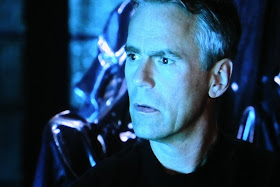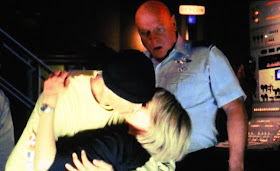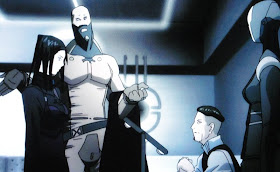 Is it me or do you miss this guy too? Okay, call it a man crush, but I loved Richard Dean Anderson as Jack O'Neill. He was a big part of why I loved Stargate SG-1. This image from Abyss is arguably one of his most memorable performance in the series. Of course, there were many...
Is it me or do you miss this guy too? Okay, call it a man crush, but I loved Richard Dean Anderson as Jack O'Neill. He was a big part of why I loved Stargate SG-1. This image from Abyss is arguably one of his most memorable performance in the series. Of course, there were many...








 It's time for a bit of fun with the latest SciFiNow Top 10 list.
It's time for a bit of fun with the latest SciFiNow Top 10 list.Thinking about it, I began writing this blog as Stargate SG-1 the series was coming to an end. I viewed it in its entirety watching on DVD. That was the last science fiction program I had watched before beginning Musings Of A Sci-Fi Fanatic. It was much easier to watch science fiction without having to write about it. I don't watch science fiction nearly as often as I'd like as a result of the writing, but I do enjoy the creative outlet.
I initially generated my own Sci-Fi Fanatic Ten Best before I decided to give that column a name dubbed the BIG 10. Here. Let's see how SciFiNow stacks up with my own list and your feelings on the series regarding the best and worst of Stargate SG-1.
This list is extracted from the SciFiNow Timewarp Collection.
The Worst:
1. Emancipation [Season One]
2. Citizen Joe [Season Eight]
3. Out Of Mind [Season Two]
4. Insiders [Season Ten]
5. Politics [Season One]
6. Urgo [Season Three]
7. Ascension [Season Five]
8. It's Good To Be King [Season Eight]
9. Ripple Effect [Season Nine]
10. Tangent [Season Four]
 To contain things a bit, we'll work our comparisons within each specific season of the ten season run. Taking a look at the worst pick selections I couldn't agree more with the magazine's assessment of Emancipation, a truly preachy mess of a start to the series in Season One. It's defensible as the series was just getting off the ground, but it's a poorly written effort by Kathryn Powers who also penned the equally awkward Code Of Honor for Star Trek: The Next Generation Season One. She's done better.
To contain things a bit, we'll work our comparisons within each specific season of the ten season run. Taking a look at the worst pick selections I couldn't agree more with the magazine's assessment of Emancipation, a truly preachy mess of a start to the series in Season One. It's defensible as the series was just getting off the ground, but it's a poorly written effort by Kathryn Powers who also penned the equally awkward Code Of Honor for Star Trek: The Next Generation Season One. She's done better.I actually really enjoyed Citizen Joe with guest star Dan Castellaneta. It's a completely stand alone episode, but it's a joy to watch Castellaneta's performance even if it doesn't feel entirely like Stargate SG-1. You can't place it among the worst.
Out Of Mind may not be the best season-ender in the Stargate SG-1 series, but it's far from the worst. Season Two easily has other options from which to choose. One False Step is a good example.
Insiders is a solid entry focusing on the Baal character. This is not the worst moment of Season 10.
Politics is essentially a clips/filler episode and a bit of a bore at that. I can't argue against this selection. It deserves a placement among the worst. You'd be hard-pressed to locate something worse than Politics in Season One. Emancipation, of course, but that might edge out this one.
Urgo, guest-starring Director Peter DeLuise's father Dom DeLuise, the one and only classic comedian, simply isn't funny and drags. A perfect selection for the worst list unfortunately for Peter.
Ascension from Season Five is not particularly memorable, but I'm not sure it's a candidate for the worst list featuring good performances from Amanda Tapping and guest star Sean Patrick Flanery. You could make a case for others from the season. Unfortunately the honor for the worst should go to Wormhole X-treme! starring yet another DeLuise family member, brother Michael DeLuise. Sorry Peter. Truthfully I love much of Peter DeLuise's work. I know I sound like a DeLuise detractor here and that's really not the case.
It's Good To Be King really deserves a place outside of the worst list. It's better than that. In fact, SciFiNow has selected two entries from what I consider to be a very strong Season Eight on the whole. Citizen Joe and It's Good To Be King aren't that bad and I would suggest looking outside of Season Eight for other options.
 Ripple Effect is a fine example of a reasonably solid Season Nine of Stargate SG-1 with its addition of Ben Browder (Farscape). It's hard to pick a bad episode from the season. Thematically the season is unified in its approach and story. It was solid overall.
Ripple Effect is a fine example of a reasonably solid Season Nine of Stargate SG-1 with its addition of Ben Browder (Farscape). It's hard to pick a bad episode from the season. Thematically the season is unified in its approach and story. It was solid overall.Finally, Tangent isn't perfect, but it's an interesting idea and delivers a good episode with strong performances. The material is simple, but it's not thin. One could easily look elsewhere within Season Four for a candidate.
These lists are always subjective, but there are some episodes that are almost universally scorned or loved. Here is a look at the best of Stargate SG-1.
The Best:
1. 200 [Season Ten]
2. Talion [Season Ten]
3. Babylon [Season Nine]
4. The Torment Of Tantalus [Season One]
5. The Changeling [Season Six]
6. Abyss [Season Six]
7. Heroes [Season Seven]
8. Window Of Opportunity [Season Four]
9. Within The Serpent's Grasp [Season One]
10. There But For The Grace Of God [Season One]
I'm not sure 200 deserves a spot in the best, but in terms of sheer creativity it's a classic in that way.
Talion? Really.
Babylon is not the worst, but is hardly memorable in terms of classic status. As I mentioned earlier, Season Nine is strong and noteworthy for its uniform genius following the departure of Richard Dean Anderson. Still, Babylon isn't the best episode in that season. I preferred others including Beachhead and Camelot to name two.
 Season One's The Torment Of Tantalus is certainly a fan favorite and it is a beautiful episode. I can't argue with its position here among the best. It is indeed a deserving entry and one that seems to grow stronger with time. An early appearance by future Stargate Atlantis regular alum Paul McGillion makes a brief cameo here long before landing the role of Carson Beckett for the spinoff.
Season One's The Torment Of Tantalus is certainly a fan favorite and it is a beautiful episode. I can't argue with its position here among the best. It is indeed a deserving entry and one that seems to grow stronger with time. An early appearance by future Stargate Atlantis regular alum Paul McGillion makes a brief cameo here long before landing the role of Carson Beckett for the spinoff.The Teal'c-heavy The Changeling is good, but I would choose something other than that entry from Season Six. I think the Teal'c-heavy Redemption might be even better.
A much better Season Six choice for the best list is Abyss. This is a beautifully directed and classic episode. In fact, how I missed this one when I wrote my original list is something of a mystery. Abyss would easily supplant something from my own list. It is a great selection and a fan favorite. Here is a wonderful moment from the episode starring none other than Richard Dean Anderson. It's not the entire performance, but a nice example of his talent on display in Abyss.
The Abyss pick is quickly followed by another masterpiece in Heroes. The events that unfold coupled with the superb direction and action of the two-parter are mind-blowing. It made my list and this is an easy recommendation for a best list. It is also a fan favorite.
 Like The Torment Of Tantalus it's easy to understand why Window Of Opportunity is on this list. It is arguably one of the best episodes of Season Four. To underline my earlier point it was directed by Peter DeLuise. It is an impressive installment within the franchise. Call my natural affection for the Carter and O'Neill relationship (with potential) what you will. This shipper loves it. See my post on O'Neill and Carter for a bit of fun.
Like The Torment Of Tantalus it's easy to understand why Window Of Opportunity is on this list. It is arguably one of the best episodes of Season Four. To underline my earlier point it was directed by Peter DeLuise. It is an impressive installment within the franchise. Call my natural affection for the Carter and O'Neill relationship (with potential) what you will. This shipper loves it. See my post on O'Neill and Carter for a bit of fun.Within The Serpent's Grasp is easily acceptable as one of the best entries of Season One. Personally, I would look elsewhere for a Top 10 placement even though the choice is logical. At least this one makes sense.
There But For The Grace Of God is another sentimental favorite from the Stargate SG-1 early years. There's definitely a great deal of love represented here for Season One. I can't argue against the episode. It's a solid entry.
 Ultimately, Stargate SG-1 is a tough series to place in a Top 10 bottle with over two hundred episodes to choose from, but there's plenty for fans to make cases for and against. Overall, what a solid science fiction series from start to finish for a host of reasons. It's a truly remarkable achievement. Indeed.
Ultimately, Stargate SG-1 is a tough series to place in a Top 10 bottle with over two hundred episodes to choose from, but there's plenty for fans to make cases for and against. Overall, what a solid science fiction series from start to finish for a host of reasons. It's a truly remarkable achievement. Indeed.

































